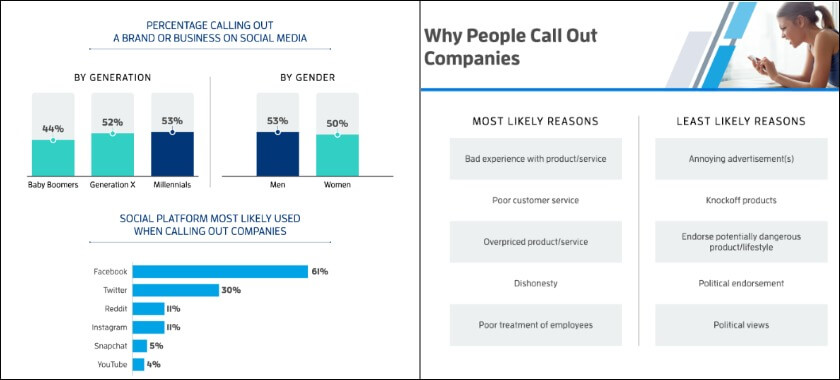89% of companies across industries compete primarily based on customer experience. The pandemic has underscored this further. Customers echo that for them, experience is as important as the final product or service delivered. To understand how your company competes for market and consumer mind share, surveys and CSATs have been the norm. But, imagine knowing what your customers and prospects think about your product or service, without having to actively ask them. Imagine getting an unbiased and authentic pulse of your brand without nudging your audience. That’s where sentiment analysis comes in.
What is sentiment analysis?
Simply put, sentiment analysis helps companies decode whether consumer attitude towards their brand is positive, negative, or neutral. It does this by mining unstructured text and review data to evaluate human feelings about your product or service. By employing natural language processing (NLP) and text analytics, sentiment analysis can assist businesses in drawing insights from rapidly changing consumer behavior. Moreover, it’s less time and labor-intensive and affords scale across millions of data points.
To know how your business can leverage sentiment analysis to provide a distinctive and frictionless customer experience, read on.
1. Analyze data across multiple social profiles to spot crisis early
Distressed customers turn to social media to vent their feelings, and organizations can hardly tell when one negative comment can spiral into a serious PR crisis. A study commissioned by Google reveals that only 43% of companies use unified cross-platform analytics; which makes the rest highly vulnerable to such unexpected scenarios. Constantly monitoring and analyzing content from multiple social networks and online data streams is important.

But what’s more crucial is processing these data points through sentiment analysis to contextualize the gravity of a crisis: whether it’s a negative sentiment brimming across the majority or few but very angry consumers. These insights will help prioritize your crisis communication to address the most pressing issues before the situation escalates.
In 2018, Nike released a bold ad featuring an ex-NFL quarterback Colin Kaepernick, who protested against police brutality. While most social media coverages focused on the negative consumer reception, the brand found that there was a lot of positive feedback that went unnoticed. The company was able to stay its ground post the ad’s release, confident that it was winning more hearts than losing sales to boycotts. The positive sentiment earned helped increase Nike’s overall sales by over 31%.
2. Monitor brand health to enhance product and service quality
Brand health relies on various metrics like awareness, positioning, reputation, and brand equity among others. All of these find their nexus in your consumer experiences. Social media interactions, website inquiries, product reviews, and purchase decisions – each of these cumulatively cater to reflect a positive or negative brand image. Over time, this perception can evolve and affect your general brand health.
As a company, there could be times when your brand awareness is at an all-time high, but your purchase intent may be suffering; your customers may love your services, but the overall brand reputation is not up to the mark. Sentiment analysis can provide accurate insights into what’s hurting and what’s benefiting your sales by monitoring your brand health. Sentiment analysis enables you to answer key business questions such as:
- How often are people talking about my brand?
- What percentage of a category conversation is dominated by my brand?
- How is the audience’s general perception of my brand?
- What is the percentage of good, bad, and neutral mentions around my brand for a specific period?
- How does my brand’s net sentiment score look?
- How likely are people to go from knowing my brand to buying the products or services?
Brand health affects your consumer’s purchase intent. Monitoring and analyzing the overall brand sentiment can help identify and fill product/ service gaps and iron out inconsistencies to ultimately provide a conversion-driven, superior digital customer experience.
3. Dig deep into Voice of Customer to gauge marketing communication effectiveness
Customers want to be heard. They will connect with your brand better when your marketing communications reflect their current mindset and speak their language. Here’s where Voice of Customer (VoC) sentiment analysis becomes indispensable.
VoC helps you scour through various forms of customer feedback, call center transcripts, etc., to distill typical terms or keywords your customers use to describe a pain point or voice an issue. Savvy marketers then use these terms to their advantage to develop targeted marketing copy across channels. For instance, a landing page filled with superfluous jargon may look compelling to you and your higher management. But, unless it echoes your customer’s feelings in words, these efforts will render futile.
Traditional marketing communication metrics focus on capturing views, clicks, comments, and shares. Whereas, sentiment analysis taps into the quality of your interactions. It decodes the VoC by focusing on:
- Understanding how different sets of audiences react to your marketing messages online. This helps you refine future campaigns for maximum impact
- Identifying consumer segments that respond positively to ongoing marketing initiatives. This helps you craft tailored messages to keep resonating with them
- Signaling promptly on marketing messages that bring in flak
A pertinent example would be how we helped a global IT leader increase its product usage and identify effective marketing channels to boost engagement by leveraging VoC sentiment analysis.
4. Understand how your brand compares in the industry to drive informed decision-making
In a highly competitive environment, businesses can’t afford to be myopic in the data streams they review, to gauge their performance. In addition to monitoring your online mentions, sentiment analysis tools allow you to track your competitors’ online customer conversations. Positive sentiments around a competitor brand can help you identify what’s working well for them and across which platforms. Whereas, negative competitor sentiments can reveal whitespace opportunities to harness in terms of a product update or service innovation.
For instance, in a fiercely competitive space like automotive, a sentiment analysis was conducted to understand customer opinions about the most popular car brands by analyzing relevant tweets. The data revealed that while BMW outperformed Audi and Mercedes under ‘joy’ as an emotional classification, Audi (83%) won over Mercedes (79%) and BMW (72%) in terms of positive polarity.
Furthermore, if a competitor’s marketing campaign is performing better than yours, examining the audience response in detail can help identify the most effective tactics. Analyzing sentiment based on keywords in your industry can further enable your brand to improve your communications and generate new leads.
For many companies, separating noise from the right consumer signals is a constant challenge. And while sentiment analysis is a robust solution, it’s important to partner with experts who know to tackle its limitations while delivering the insights you need to take prompt customer-centric decisions.
Leading enterprises across industries have relied on Netscribes’ expertise to uncover these insights. To know how our social media intelligence solutions can help you confidently refine customer experience and improve your brand perception, contact us.






